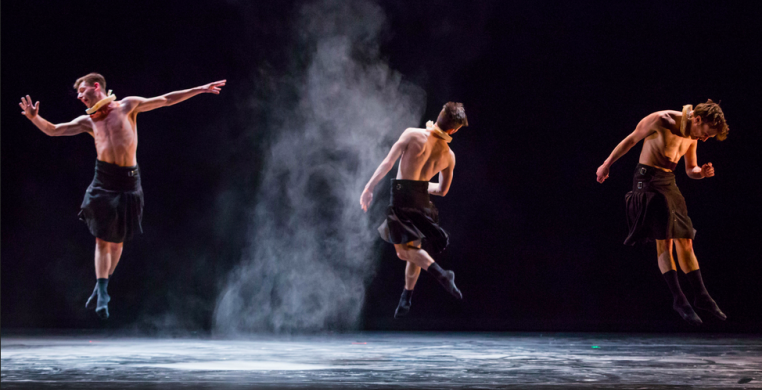Visceral Dance Chicago is a fledgling company, but you wouldn’t know it by looking at them. The company’s latest spring series, a one-nighter April 9 at the Harris Theater for Music and Dance, was certainly no exception. At times, Visceral is a company that presents with multiple personalities, ping ponging between styles and voices over its three seasons to see where the pendulum rests.
Artistic Director Nick Pupillo is also the company’s primary choreographer. His vocabulary is firmly rooted in ballet, while his commissions tilt much more toward contemporary, leading the viewer to wonder if his works might be place holders while a stock of repertory builds. The exception is Pupillo’s She Three (2015), which bucks his m.o. for large, schmaltzy ballets, and on this program followed his tango-inspired The Last Round, premiered earlier this year.
She Three opens with three women prostrate, folding and unfolding their bodies under Goldmund’s lullaby-like score, illuminated by three spotlights hung from a downstage electric hovering just feet above them. We’ve seen moves like this from lighting designer Brian Sidney Bembridge before, and it really doesn’t get old. Simply put, the opening of this piece is stunning. The women noodle through passages of movement, isolated in their respective lights, sometimes together, sometimes not. As one might expect, they eventually come together, moving in and out of partnering as the stage light opens up, which is fine, but I could have watched that bit in the beginning forever. She Three draws virtue from its difference to Pupillo’s other works, among other things, and falls nicely in the middle between the various aesthetics his company attempts.
Irish choreographer Marguerite Donlon’s Ruff Celts premiered mid-way through the evening, and the full company piece is about as good as it gets. The men don kilts, with the women in black boy-cut leos; all are adorned with white Elizabethan ruffs and periodically throw puffs of white powder in the air. With its black socks, quirky gestures, and stark European aesthetic, Ruff Celts could be mistaken for a seventh Kylián Black and White Ballet if not for its Irish-themed shenanigans. What I can’t know or understand about the piece (aside from what goes on in Donlon’s brilliant mind), is whether the sarcastic nod to old English elite is an intentionally Irish jab, or just for plain fun. I have to assume the former.
Equally cheeky, but totally different, is Fernando Melo’s Bate. The 2015 work features the company’s men, who spend much of the piece behind a blackout screen. Gesticulations of hands, feet, and dancer Brandon Coleman’s mug appear through peek-a-boo holes in the screen, expertly timed, until a larger gap in the middle culminates with a fantastic series of cuddle puddles. The men deflate and inflate, resembling those red, floppy AirDancers at a car dealership. The upstage screen rises, and the dance opens up into a series of group phrases; as with See Three, these sections are less impactful than the gold nuggets at each work’s beginning.
As a bookend with the balletic The Last Round, Pupillo’s Vital closes the program in grand fashion and tiny white leotards. It is a more classic Pupillo dance; with its high kicks and elaborate partnering, the piece echoes his earlier Impetere. But Vital is fortunately messier and more broken-in than Impetere. Perhaps it is the presence of a live musician onstage and Maguerite Donlon’s regal statue built of coat hangers, or the fact that this group of dancers is as gelled as ever, but this ballet shows more reckless abandon than usual, and it’s totally refreshing.

